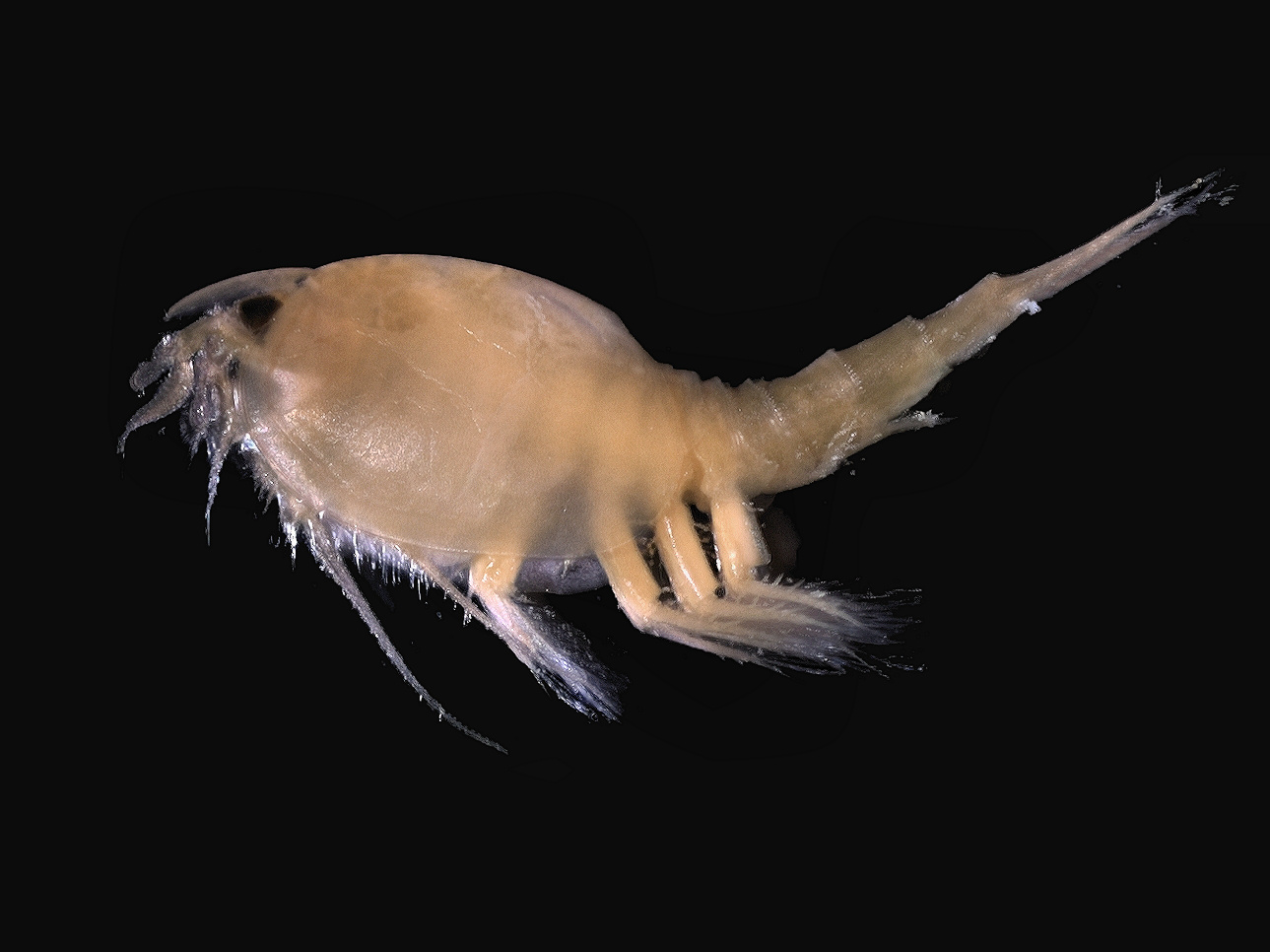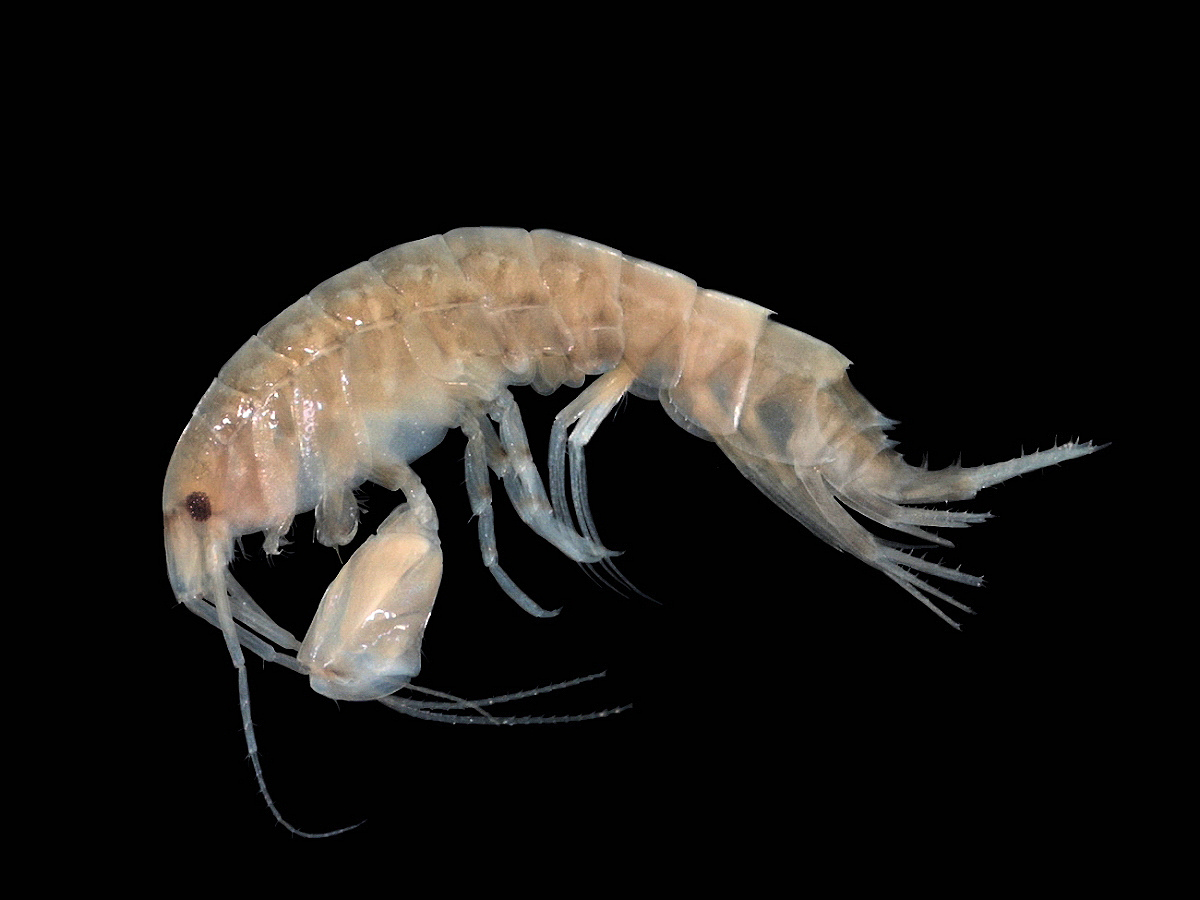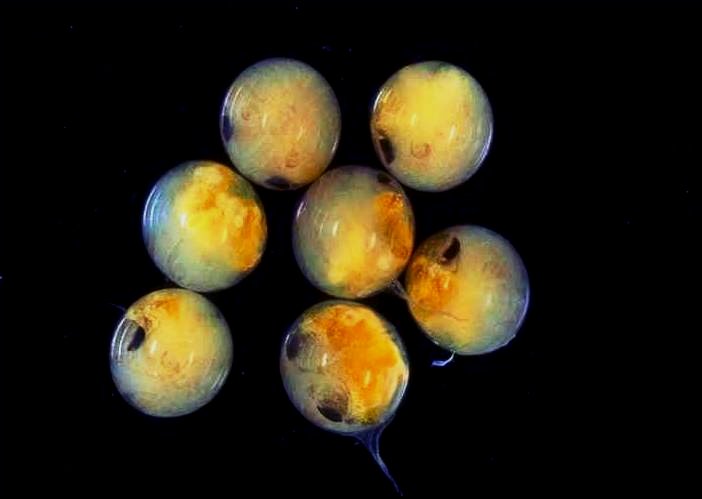|
Entomostraca
Entomostraca is a historical subclass of crustaceans, no longer in technical use. It was originally considered one of the two major lineages of crustaceans (the other being the class Malacostraca), combining all other classes—Branchiopoda, Cephalocarida, Ostracoda, Copepoda and the obsolete Maxillopoda. The Ostracoda have the body enclosed in a bivalve shell-covering, and are normally unsegmented. The Branchiopoda have a very variable number of body-segments, with or without a shield, simple or bivalved, and some of the post-oral appendage An appendage (or outgrowth) is an external body part or natural prolongation that protrudes from an organism's body such as an arm or a leg. Protrusions from single-celled bacteria and archaea are known as cell-surface appendages or surface app ...s normally branchial. The Copepoda normally have a segmented body, not enclosed in a bi-valved shell-covering, fewer than twelve segments, the limbs not branchial. References WordNet Dictio ... [...More Info...] [...Related Items...] OR: [Wikipedia] [Google] [Baidu] |
Malacostraca
Malacostraca is the second largest of the six classes of pancrustaceans behind insects, containing about 40,000 living species, divided among 16 orders. Its members, the malacostracans, display a great diversity of body forms and include crabs, lobsters, spiny lobsters, crayfish, shrimp, krill, prawns, isopods, amphipods, mantis shrimp, and many other less familiar animals. They are abundant in all marine environments and have colonised freshwater and terrestrial habitats. They are segmented animals, united by a common body plan comprising 20 body segments (rarely 21), and divided into a head, thorax, and abdomen. Etymology The name Malacostraca is . The word was used by Aristotle, who contrasted them with oysters, in comparison with which their shells are pliable. It was applied to this taxon by French zoologist Pierre André Latreille in 1802. He was curator of the arthropod collection at the National Museum of Natural History in Paris. This scientific name is misl ... [...More Info...] [...Related Items...] OR: [Wikipedia] [Google] [Baidu] |
Branchiopoda
Branchiopoda, from Ancient Greek βράγχια (''bránkhia''), meaning "gill", and πούς (''poús''), meaning "foot", is a class (biology), class of crustaceans. It comprises Anostraca, fairy shrimp, clam shrimp, Diplostraca (or Cladocera), Notostraca, the Devonian ''Lepidocaris'' and possibly the Cambrian ''Rehbachiella''. They are mostly small, freshwater animals that feed on plankton and detritus. Description Members of the Branchiopoda are unified by the presence of gills on many of the animals' appendages, including some of the arthropod mouthparts, mouthparts. This is also responsible for the name of the group (from the , gills, akin to , windpipe; , foot). They generally possess compound eyes and a carapace, which may be a shell of two valves enclosing the trunk (as in most Cladocera), broad and shallow (as in the Notostraca), or entirely absent (as in the Anostraca). In the groups where the carapace prevents the use of the trunk limbs for swimming (Cladocera and clam ... [...More Info...] [...Related Items...] OR: [Wikipedia] [Google] [Baidu] |
Streptocephalus
''Streptocephalus'' is a genus of fairy shrimp found in temporary waters in Africa, Australia, Eurasia, and Central and North America, following its ancient origin in Gondwana. It contains the following species: *'' Streptocephalus annanarivensis'' Thiele, 1907 *'' Streptocephalus antillensis'' Mattox, 1950 *'' Streptocephalus areva'' Brehm, 1954 *'' Streptocephalus bidentatus'' Hamer & Appleton, 1993 *'' Streptocephalus bimaris'' Gurney, 1909 *'' Streptocephalus bourquinii'' Hamer & Appleton, 1993 *'' Streptocephalus bouvieri'' Daday, 1908 *'' Streptocephalus cafer'' (Lovén, 1847) *'' Streptocephalus caljoni'' Beladjal, Mertens & Dumont, 1996 *'' Streptocephalus cirratus'' Daday, 1908 *''Streptocephalus cladophorus'' Barnard, 1924 *'' Streptocephalus coomansi'' Brendonck & Belk, 1993 *'' Streptocephalus dendrophorus'' Hamer & Appleton, 1993 *'' Streptocephalus dendyi'' Barnard, 1929 *'' Streptocephalus dichotomus'' Baird, 1860 *'' Streptocephalus distinctus'' Thiele, 1907 *'' S ... [...More Info...] [...Related Items...] OR: [Wikipedia] [Google] [Baidu] |
Animal
Animals are multicellular, eukaryotic organisms in the Biology, biological Kingdom (biology), kingdom Animalia (). With few exceptions, animals heterotroph, consume organic material, Cellular respiration#Aerobic respiration, breathe oxygen, have myocytes and are motility, able to move, can reproduce sexually, and grow from a hollow sphere of Cell (biology), cells, the blastula, during embryonic development. Animals form a clade, meaning that they arose from a single common ancestor. Over 1.5 million extant taxon, living animal species have been species description, described, of which around 1.05 million are insects, over 85,000 are molluscs, and around 65,000 are vertebrates. It has been estimated there are as many as 7.77 million animal species on Earth. Animal body lengths range from to . They have complex ecologies and biological interaction, interactions with each other and their environments, forming intricate food webs. The scientific study of animals is known as ... [...More Info...] [...Related Items...] OR: [Wikipedia] [Google] [Baidu] |
Arthropoda
Arthropods ( ) are invertebrates in the phylum Arthropoda. They possess an exoskeleton with a cuticle made of chitin, often mineralised with calcium carbonate, a body with differentiated ( metameric) segments, and paired jointed appendages. In order to keep growing, they must go through stages of moulting, a process by which they shed their exoskeleton to reveal a new one. They form an extremely diverse group of up to ten million species. Haemolymph is the analogue of blood for most arthropods. An arthropod has an open circulatory system, with a body cavity called a haemocoel through which haemolymph circulates to the interior organs. Like their exteriors, the internal organs of arthropods are generally built of repeated segments. They have ladder-like nervous systems, with paired ventral nerve cords running through all segments and forming paired ganglia in each segment. Their heads are formed by fusion of varying numbers of segments, and their brains are formed by fu ... [...More Info...] [...Related Items...] OR: [Wikipedia] [Google] [Baidu] |
Crustacean
Crustaceans (from Latin meaning: "those with shells" or "crusted ones") are invertebrate animals that constitute one group of arthropods that are traditionally a part of the subphylum Crustacea (), a large, diverse group of mainly aquatic arthropods including decapods (shrimps, prawns, crabs, lobsters and crayfish), seed shrimp, branchiopods, fish lice, krill, remipedes, isopods, barnacles, copepods, opossum shrimps, amphipods and mantis shrimp. The crustacean group can be treated as a subphylum under the clade Mandibulata. It is now well accepted that the hexapods (insects and entognathans) emerged deep in the Crustacean group, with the completed pan-group referred to as Pancrustacea. The three classes Cephalocarida, Branchiopoda and Remipedia are more closely related to the hexapods than they are to any of the other crustaceans ( oligostracans and multicrustaceans). The 67,000 described species range in size from '' Stygotantulus stocki'' at , to the Japanese ... [...More Info...] [...Related Items...] OR: [Wikipedia] [Google] [Baidu] |
Subclass (biology)
In Taxonomy (biology), biological classification, class () is a taxonomic rank, as well as a taxonomic unit, a taxon, in that rank. It is a group of related taxonomic orders. Other well-known ranks in descending order of size are Domain (biology), domain, Kingdom (biology), kingdom, phylum, Order (biology), order, Family (biology), family, genus, and species, with class ranking between phylum and order. History The class as a distinct rank of biological classification having its own distinctive name – and not just called a ''top-level genus'' ''(genus summum)'' – was first introduced by France, French botanist Joseph Pitton de Tournefort in the classification of plants that appeared in his ''Eléments de botanique'' of 1694. Insofar as a general definition of a class is available, it has historically been conceived as embracing taxa that combine a distinct ''grade'' of organization—i.e. a 'level of complexity', measured in terms of how differentiated their organ systems ... [...More Info...] [...Related Items...] OR: [Wikipedia] [Google] [Baidu] |
Crustacean
Crustaceans (from Latin meaning: "those with shells" or "crusted ones") are invertebrate animals that constitute one group of arthropods that are traditionally a part of the subphylum Crustacea (), a large, diverse group of mainly aquatic arthropods including decapods (shrimps, prawns, crabs, lobsters and crayfish), seed shrimp, branchiopods, fish lice, krill, remipedes, isopods, barnacles, copepods, opossum shrimps, amphipods and mantis shrimp. The crustacean group can be treated as a subphylum under the clade Mandibulata. It is now well accepted that the hexapods (insects and entognathans) emerged deep in the Crustacean group, with the completed pan-group referred to as Pancrustacea. The three classes Cephalocarida, Branchiopoda and Remipedia are more closely related to the hexapods than they are to any of the other crustaceans ( oligostracans and multicrustaceans). The 67,000 described species range in size from '' Stygotantulus stocki'' at , to the Japanese ... [...More Info...] [...Related Items...] OR: [Wikipedia] [Google] [Baidu] |
Cephalocarida
The Cephalocarida, from Ancient Greek κεφαλή (''kephalḗ''), meaning "head", and καρίς (''karís''), meaning "shrimp", are a class in the subphylum Crustacea comprising only 12 species. Both the nauplii and the adults are benthic. They were discovered in 1955 by Howard L. Sanders, and are commonly referred to as horseshoe shrimp. They have been grouped together with the Remipedia in the Xenocarida. Although a second family, Lightiellidae, is sometimes used, all cephalocaridans are generally considered to belong in just one family: Hutchinsoniellidae. Fossil records of cephalocaridans have been found in the Ordovician Castle Bank site. Taxonomy * Class Cephalocarida Sanders 1955 ** Order Brachypoda Birshteyn 1960 *** Family Hutchinsoniellidae Sanders 1955 **** Genus '' Chiltoniella'' Knox & Fenwick 1977 ***** ''Chiltoniella elongata'' Knox & Fenwick 1977 **** Genus '' Hampsonellus'' Hessler & Wakabara 2000 ***** ''Hampsonellus brasiliensis'' Hessler & Wakabara 200 ... [...More Info...] [...Related Items...] OR: [Wikipedia] [Google] [Baidu] |
Ostracod
Ostracods, or ostracodes, are a Class (biology), class of the crustacean, Crustacea (class Ostracoda), sometimes known as seed shrimp. Some 33,000 species (only 13,000 of which are extant taxon, extant) have been identified,Brandão, S.N.; Antonietto, L.S; Nery, D.G.; Santos, S.G.; Karanovic, I. (2023). World Ostracoda Database. Accessed at https://www.marinespecies.org/ostracoda on 2023-09-12. grouped into 7 valid orders. They are small crustaceans, typically around in size, but varying from , the latter in the case of the marine ''Gigantocypris.'' The largest known freshwater species is ''Megalocypris princeps'', which reach 8 mm in length. In most cases, their bodies are flattened from side to side and protected by a bivalve-like valve or "shell" made of chitin, and often calcium carbonate. The family Entocytheridae and many planktonic forms do not have calcium carbonate. The hinge of the two valves is in the upper (dorsal) region of the body. Ostracods are grouped toget ... [...More Info...] [...Related Items...] OR: [Wikipedia] [Google] [Baidu] |
Copepod
Copepods (; meaning 'oar-feet') are a group of small crustaceans found in nearly every freshwater and saltwater habitat (ecology), habitat. Some species are planktonic (living in the water column), some are benthos, benthic (living on the sediments), several species have Parasitism, parasitic phases, and some continental species may live in limnoterrestrial habitats and other wet terrestrial places, such as swamps, under leaf fall in wet forests, bogs, springs, ephemeral ponds, puddles, damp moss, or water-filled recesses of plants (phytotelmata) such as bromeliads and pitcher plants. Many live underground in marine and freshwater caves, sinkholes, or stream beds. Copepods are sometimes used as Ecological indicator, biodiversity indicators. As with other crustaceans, copepods have a larval form. For copepods, the egg hatches into a Crustacean larvae#Nauplius, nauplius form, with a head and a tail but no true thorax or abdomen. The larva molts several times until it resembles the a ... [...More Info...] [...Related Items...] OR: [Wikipedia] [Google] [Baidu] |
Maxillopoda
Crustaceans (from Latin meaning: "those with shells" or "crusted ones") are invertebrate animals that constitute one group of arthropods that are traditionally a part of the subphylum Crustacea (), a large, diverse group of mainly aquatic arthropods including decapods (shrimps, prawns, crabs, lobsters and crayfish), seed shrimp, branchiopods, fish lice, krill, remipedes, isopods, barnacles, copepods, opossum shrimps, amphipods and mantis shrimp. The crustacean group can be treated as a subphylum under the clade Mandibulata. It is now well accepted that the hexapods (insects and entognathans) emerged deep in the Crustacean group, with the completed pan-group referred to as Pancrustacea. The three classes Cephalocarida, Branchiopoda and Remipedia are more closely related to the hexapods than they are to any of the other crustaceans ( oligostracans and multicrustaceans). The 67,000 described species range in size from '' Stygotantulus stocki'' at , to the Japanese spider cr ... [...More Info...] [...Related Items...] OR: [Wikipedia] [Google] [Baidu] |








